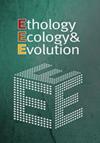类人猿物种、个体和社会单位的手势交流的社会生态学观点
IF 1.3
4区 生物学
Q4 BEHAVIORAL SCIENCES
引用次数: 11
摘要
在过去的30年里,大多数关于非人类灵长类动物手势交流的研究都是由心理学家进行的,他们塑造了提出的问题和使用的方法。这些研究人员借鉴了哲学、语言学、人类学和动物行为学的概念,但尽管这些概念影响广泛,但该领域却忽视了将手势置于不同物种、个体和社会单位存在的社会生态背景中。在这篇综述中,我们介绍了目前关于类人猿手势交流的知识,包括它们的功能、意义和发展。我们将此纳入关于其他类人猿社会行为变异的讨论中,以确定未来研究手势交流变异的领域。考虑到不同物种和社会单位(以及这些群体中的个体)的社会生态因素的巨大差异,我们可能会发现对特定手势类型的不同偏好;传达特定含义的不同需求;以及遇到特定情境的不同比率。新工具,如基于机器学习的自动运动跟踪,可以让我们发现手势动作的速度和形式或部分手势动作的潜在变化。新的多组多代数据集提供了应用分析的机会,例如贝叶斯模型,它允许我们检查这些丰富的行为景观。总之,通过扩展我们的问题和方法,研究人员可能最终能够从类人猿本身的角度研究类人猿的手势,并探索这种手势交流系统揭示了类人猿对世界的思考和体验。本文章由计算机程序翻译,如有差异,请以英文原文为准。
A socio-ecological perspective on the gestural communication of great ape species, individuals, and social units
Over the last 30 years, most research on non-human primate gestural communication has been produced by psychologists, which has shaped the questions asked and the methods used. These researchers have drawn on concepts from philosophy, linguistics, anthropology, and ethology, but despite these broad influences the field has neglected to situate gestures into the socio-ecological context in which the diverse species, individuals, and social-units exist. In this review, we present current knowledge about great ape gestural communication in terms of repertoires, meanings, and development. We fold this into a conversation about variation in other types of ape social behaviour to identify areas for future research on variation in gestural communication. Given the large variation in socio-ecological factors across species and social-units (and the individuals within these groups), we may expect to find different preferences for specific gesture types; different needs for communicating specific meanings; and different rates of encountering specific contexts. New tools, such as machine-learning based automated movement tracking, may allow us to uncover potential variation in the speed and form of gesture actions or parts of gesture actions. New multi-group multi-generational datasets provide the opportunity to apply analyses, such as Bayesian modelling, which allows us to examine these rich behavioural landscapes. Together, by expanding our questions and our methods, researchers may finally be able to study great ape gestures from the perspective of the apes themselves and explore what this gestural communication system reveals about apes’ thinking and experience of their world.
求助全文
通过发布文献求助,成功后即可免费获取论文全文。
去求助
来源期刊

Ethology Ecology & Evolution
生物-动物学
CiteScore
3.10
自引率
0.00%
发文量
44
审稿时长
>12 weeks
期刊介绍:
Ethology Ecology & Evolution is an international peer reviewed journal which publishes original research and review articles on all aspects of animal behaviour, ecology and evolution. Articles should emphasise the significance of the research for understanding the function, ecology, evolution or genetics of behaviour. Contributions are also sought on aspects of ethology, ecology, evolution and genetics relevant to conservation.
Research articles may be in the form of full length papers or short research reports. The Editor encourages the submission of short papers containing critical discussion of current issues in all the above areas. Monograph-length manuscripts on topics of major interest, as well as descriptions of new methods are welcome. A Forum, Letters to Editor and Book Reviews are also included. Special Issues are also occasionally published.
 求助内容:
求助内容: 应助结果提醒方式:
应助结果提醒方式:


